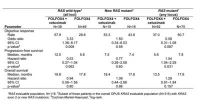(Press-News.org) Researchers have developed new methods to trace the life history of individual cells back to their origins in the fertilised egg. By looking at the copy of the human genome present in healthy cells, they were able to build a picture of each cell's development from the early embryo on its journey to become part of an adult organ.
During the life of an individual, all cells in the body develop mutations, known as somatic mutations, which are not inherited from parents or passed on to offspring. These somatic mutations carry a coded record of the lifetime experiences of each cell.
By looking at the numbers and types of mutations in a cell's DNA, researchers were able to assess whether the cell had divided a few times or many times and detect the imprints, known as signatures, of the processes of DNA damage and repair that the cells had been exposed to during the life of the individual. Furthermore, comparing each cell's mutations with those of other cells in the body enabled scientists to map out a detailed tree of development from the fertilised egg.
"With this novel approach, we can peer back into an organism's development," says Dr Sam Behjati, first author from the Wellcome Trust Sanger Institute. "If we can better understand how normal, healthy cells mutate as they divide over a person's lifetime, we will gain a fundamental insight into what can be considered normal and how this differs from what we see in cancer cells."
The team looked at mouse cells from the stomach, small bowel, large bowel and prostate. The single cells were grown to produce enough DNA to be sequenced accurately. Eventually, single-cell sequencing technology will develop so that this type of experiment can be conducted using just one cell. However, the tiny amounts of DNA in single cells mean that mutation data are not currently precise enough to reconstruct accurate lineages.
The researchers recorded differences in the numbers of mutations in cells from the different tissues studied, likely attributable to differences in rates of cell division. Moreover, different patterns of mutation were found in cells from different tissues, suggesting that they have been exposed to different processes of DNA damage and repair, reflecting different lifetime experiences.
This experiment used healthy mice. If mutation rates are similar in human cells, these techniques could be used to provide an insight into the life histories of normal human cells.
"The adult human body is composed of 100 million million cells, all of which have originated from a single fertilised egg," says Professor Mike Stratton, senior author and Director of the Sanger Institute. "Much more extensive application of this approach will allow us to provide a clear picture of how adult cells have developed from the fertilised egg. Furthermore, by looking at the numbers and types of mutation in each cell we will be able to obtain a diary, writ in DNA, of what each healthy cell has experienced during its lifetime, and then explore how this changes in the range of human diseases."
INFORMATION:
Notes to Editors
Publication Details
Behjati et al. (2014) Genome sequencing of normal cells reveals developmental lineages and mutational processes. Nature DOI: 10.1038/nature13448
Participating Centres
Please see the paper for a full list of participating centres.
Selected Websites
The Hubrecht Institute for Developmental Biology and Stem Cell Research focuses on developmental biology and stem cells at the organismal, cellular, genetic, genomic and proteomic level. Basic insight into development and into stem cells will provide insight into (human) disease, such as cancer. The Hubrecht Institute is affiliated with the University Medical Center Utrecht and has close connections with the Utrecht University.
http://www.hubrecht.eu/
The Wellcome Trust Sanger Institute is one of the world's leading genome centres. Through its ability to conduct research at scale, it is able to engage in bold and long-term exploratory projects that are designed to influence and empower medical science globally. Institute research findings, generated through its own research programmes and through its leading role in international consortia, are being used to develop new diagnostics and treatments for human disease.
http://www.sanger.ac.uk
The Wellcome Trust is a global charitable foundation dedicated to achieving extraordinary improvements in human and animal health. We support the brightest minds in biomedical research and the medical humanities. Our breadth of support includes public engagement, education and the application of research to improve health. We are independent of both political and commercial interests.
http://www.wellcome.ac.uk
Reconstructing the life history of a single cell
Cell's unique mutations used to trace history back to its origins in the embryo
2014-06-29
ELSE PRESS RELEASES FROM THIS DATE:
Study finds Emperor penguin in peril
2014-06-29
An international team of scientists studying Emperor penguin populations across Antarctica finds the iconic animals in danger of dramatic declines by the end of the century due to climate change. Their study, published today in Nature Climate Change, finds the Emperor penguin "fully deserving of endangered status due to climate change."
The Emperor penguin is currently under consideration for inclusion under the US Endangered Species Act. Criteria to classify species by their extinction risk are based on the global population dynamics.
The study was conducted by lead ...
Noninvasive brain control
2014-06-29
CAMBRIDGE, MA -- Optogenetics, a technology that allows scientists to control brain activity by shining light on neurons, relies on light-sensitive proteins that can suppress or stimulate electrical signals within cells. This technique requires a light source to be implanted in the brain, where it can reach the cells to be controlled.
MIT engineers have now developed the first light-sensitive molecule that enables neurons to be silenced noninvasively, using a light source outside the skull. This makes it possible to do long-term studies without an implanted light source. ...
Bending the rules
2014-06-29
(Santa Barbara, Calif.) — For his doctoral dissertation in the Goldman Superconductivity Research Group at the University of Minnesota, Yu Chen, now a postdoctoral researcher at UC Santa Barbara, developed a novel way to fabricate superconducting nanocircuitry. However, the extremely small zinc nanowires he designed did some unexpected — and sort of funky — things.
Chen, along with his thesis adviser, Allen M. Goldman, and theoretical physicist Alex Kamenev, both of the University of Minnesota, spent years seeking an explanation for these extremely puzzling effects. ...
Improved method for isotope enrichment could secure a vital global commodity
2014-06-29
AUSTIN, Texas — Researchers at The University of Texas at Austin have devised a new method for enriching a group of the world's most expensive chemical commodities, stable isotopes, which are vital to medical imaging and nuclear power, as reported this week in the journal Nature Physics. For many isotopes, the new method is cheaper than existing methods. For others, it is more environmentally friendly.
A less expensive, domestic source of stable isotopes could ensure continuation of current applications while opening up opportunities for new medical therapies and fundamental ...
Improved survival with TAS-102 in mets colorectal cancer refractory to standard therapies
2014-06-28
The new combination agent TAS-102 is able to improve overall survival compared to placebo in patients whose metastatic colorectal cancer is refractory to standard therapies, researchers said at the ESMO 16th World Congress on Gastrointestinal Cancer in Barcelona.
"Around 50% of patients with colorectal cancer develop metastases but eventually many of them do not respond to standard therapies," said Takayuki Yoshino of the National Cancer Centre Hospital East in Chiba, Japan, lead author of the phase III RECOURSE trial. "The RECOURSE study shows that TAS-102 improves overall ...
Cetuximab or bevacizumab with combi chemo equivalent in KRAS wild-type MCRC
2014-06-28
For patients with KRAS wild-type untreated colorectal cancer, adding cetuximab or bevacizumab to combination chemotherapy offers equivalent survival, researchers said at the ESMO 16th World Congress on Gastrointestinal Cancer in Barcelona.
"The CALGB/SWOG 80405 trial was designed and formulated in 2005, and the rationale was simple: we had new drugs --bevacizumab and cetuximab-- and the study was designed to determine if one was better than the other in first-line for patients with colon cancer," said lead study author Alan P. Venook, distinguished Professor of Medical ...
Herpes virus infection drives HIV infection among non-injecting drug users in New York
2014-06-27
HIV and its transmission has long been associated with injecting drug use, where hypodermic syringes are used to administer illicit drugs. Now, a newly reported study by researchers affiliated with New York University's Center for Drug Use and HIV Research (CDUHR) in the journal PLOS ONE, shows that HIV infection among heterosexual non-injecting drug users (no hypodermic syringe is used; drugs are taken orally or nasally) in New York City (NYC) has now surpassed HIV infection among persons who inject drugs.
The study, "HSV-2 Co-Infection as a Driver of HIV Transmission ...
Potential Alzheimer's drug prevents abnormal blood clots in the brain
2014-06-27
Without a steady supply of blood, neurons can't work. That's why one of the culprits behind Alzheimer's disease is believed to be the persistent blood clots that often form in the brains of Alzheimer's patients, contributing to the condition's hallmark memory loss, confusion and cognitive decline.
New experiments in Sidney Strickland's Laboratory of Neurobiology and Genetics at Rockefeller University have identified a compound that might halt the progression of Alzheimer's by interfering with the role amyloid-β, a small protein that forms plaques in Alzheimer's brains, ...
'Bad' video game behavior increases players' moral sensitivity
2014-06-27
BUFFALO, N.Y. — New evidence suggests heinous behavior played out in a virtual environment can lead to players' increased sensitivity toward the moral codes they violated.
That is the surprising finding of a study led by Matthew Grizzard, PhD, assistant professor in the University at Buffalo Department of Communication, and co-authored by researchers at Michigan State University and the University of Texas, Austin.
"Rather than leading players to become less moral," Grizzard says, "this research suggests that violent video-game play may actually lead to increased moral ...
Ancient ocean currents may have changed pace and intensity of ice ages
2014-06-27
Climate scientists have long tried to explain why ice-age cycles became longer and more intense some 900,000 years ago, switching from 41,000-year cycles to 100,000-year cycles.
In a paper published this week in the journal Science, researchers report that the deep ocean currents that move heat around the globe stalled or may have stopped at that time, possibly due to expanding ice cover in the Northern Hemisphere.
"The research is a breakthrough in understanding a major change in the rhythm of Earth's climate, and shows that the ocean played a central role," says ...
LAST 30 PRESS RELEASES:
Making lighter work of calculating fluid and heat flow
Normalizing blood sugar can halve heart attack risk
Lowering blood sugar cuts heart attack risk in people with prediabetes
Study links genetic variants to risk of blinding eye disease in premature infants
Non-opioid ‘pain sponge’ therapy halts cartilage degeneration and relieves chronic pain
AI can pick up cultural values by mimicking how kids learn
China’s ecological redlines offer fast track to 30 x 30 global conservation goal
Invisible indoor threats: emerging household contaminants and their growing risks to human health
Adding antibody treatment to chemo boosts outcomes for children with rare cancer
Germline pathogenic variants among women without a history of breast cancer
Tanning beds triple melanoma risk, potentially causing broad DNA damage
Unique bond identified as key to viral infection speed
Indoor tanning makes youthful skin much older on a genetic level
Mouse model sheds new light on the causes and potential solutions to human GI problems linked to muscular dystrophy
The Journal of Nuclear Medicine ahead-of-print tip sheet: December 12, 2025
Smarter tools for peering into the microscopic world
Applications open for funding to conduct research in the Kinsey Institute archives
Global measure underestimates the severity of food insecurity
Child survivors of critical illness are missing out on timely follow up care
Risk-based vs annual breast cancer screening / the WISDOM randomized clinical trial
University of Toronto launches Electric Vehicle Innovation Ontario to accelerate advanced EV technologies and build Canada’s innovation advantage
Early relapse predicts poor outcomes in aggressive blood cancer
American College of Lifestyle Medicine applauds two CMS models aligned with lifestyle medicine practice and reimbursement
Clinical trial finds cannabis use not a barrier to quitting nicotine vaping
Supplemental nutrition assistance program policies and food insecurity
Switching immune cells to “night mode” could limit damage after a heart attack, study suggests
URI-based Global RIghts Project report spotlights continued troubling trends in worldwide inhumane treatment
Neutrophils are less aggressive at night, explaining why nighttime heart attacks cause less damage than daytime events
Menopausal hormone therapy may not pose breast cancer risk for women with BRCA mutations
Mobile health tool may improve quality of life for adolescent and young adult breast cancer survivors
[Press-News.org] Reconstructing the life history of a single cellCell's unique mutations used to trace history back to its origins in the embryo




